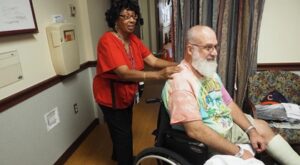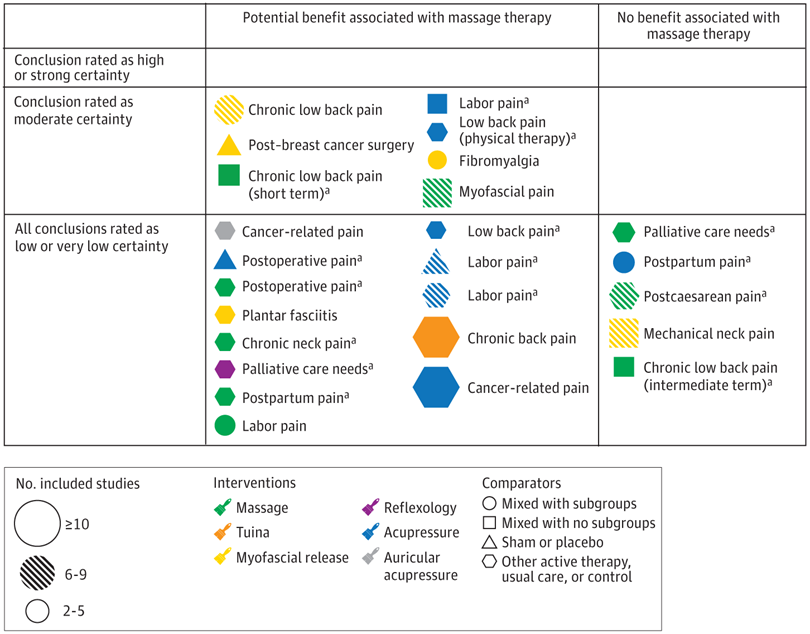
In 2019, licensed massage therapist Terry Smith, a volunteer, gave a massage to a veteran patient at the VA community living center. Photo by Jennifer Scales of the Columbia, SC, VA HealthcCare System.
LOS ANGELES — For individuals seeking relief from painful health conditions, there’s low certainty of evidence that massage therapy will ease their pain, according to a recent review article.
The review article published in JAMA Network Open evaluated the certainty or quality of evidence in recent systematic reviews for use of massage therapy for painful adult health conditions. The study authors are affiliated with the Greater Los Angeles (CA) Healthcare System.1
Massage therapy, a “popular treatment promoted for many painful adult health conditions, is sought by some patients because conventional treatments don’t always provide complete relief or may come with potential adverse effects. Studies have reported on massage therapy delivered by a variety of health care professionals, such as physical therapists, physiotherapists and nurses, but evidence of beneficial outcomes associated with massage therapy remains limited,” according to the authors.
The VA is committed to “providing evidence-based treatments, and pursues this through rigorous examinations of the evidence about potential therapies. Massage therapy is one therapy being examined,” Selene Mak, PhD, MPH, of the Greater Los Angeles Healthcare System, told U.S. Medicine.
“VA previously produced an evidence map of massage therapy for pain, which included systematic reviews published through 2018,” Mak said. “However, new evidence is constantly appearing and to categorize the newer evidence base for use in decision-making by policymakers and practitioners, VA policymakers requested a new, updated evidence map of systematic reviews published since 2018 to answer the question ‘What is the certainty of evidence in systematic reviews of massage therapy for pain?’”
In this systematic review, the authors conducted a computerized search of PubMed, the Allied and Complementary Medicine Database, the Cumulated Index to Nursing and Allied Health Literature, the Cochrane Database of Systematic Reviews and Web of Science from 2018 to 2023. They searched the five databases for relevant records published from July 2018 to April 2023 using the search terms “massage,” “acupressure,” “shiatsu,” “myofascial release therapy,” “systematic” and similar terms.
The authors included studies that were systematic reviews of massage therapy for pain in adult health conditions that formally rated the certainty, quality or strength of evidence for conclusions. They excluded studies focused on sports massage therapy, osteopathy, dry cupping or dry needling, and internal massage therapy (e.g., for pelvic floor pain), as well as self-administered massage therapy techniques, such as foam rolling, the review article reported.
The reviews were categorized as follows:
- at least one conclusion rated as high-certainty evidence,
- at least one conclusion rated as moderate-certainty evidence and
- all conclusions rated as low- or very low-certainty evidence, the study authors explained.
Overall, study authors found that “most reviews concluded that the certainty of evidence was low or very low. They identified 129 full-text articles in a search of the literature published since 2018. Of these reviews, 41 assessed the certainty or quality of evidence of their conclusions.”
“Our team identified 17 systematic reviews regarding 13 health conditions about massage therapy that had assessed certainty or quality of evidence about massage therapy for pain,” Mak said. “Most reviews concluded that ‘massage had a beneficial effect, but the certainty of evidence was low or very low.’ This means our ‘confidence in the effect estimate is limited. The true effect may be substantially different from the estimate of effect,’ or we have very little confidence in the effect estimate, according to Grading of Recommendations, Assessment, Development, and Evaluations [GRADE] working group. Despite massage therapy having been the subject of hundreds of randomized clinical trials and dozens of systematic reviews about adult health conditions since 2018, there were few conclusions that had greater than a low certainty of evidence.”

Click to Enlarge: a. This review included distinct conclusions about separate conditions and comparators, and so it appears in this map more than once. Source: JAMA Network Open
The evidence map “builds on a prior iteration of a literature review performed by this team in 2018. Massage therapy is a safe and evidence-based treatment for some conditions, and this map helps synthesize the literature for the busy clinicians who may be developing a comprehensive treatment plan with their patients which may include medical massage therapy,” Mak pointed out.
Mak explained that “studies comparing massage therapy with placebo or sham controls in place are probably not the priority. Instead, the priority should be studies comparing massage therapy with other recommended, accepted and active therapies for pain. More high-quality randomized clinical trials are needed to provide a stronger evidence base to assess the effect of massage therapy on pain.”
“For painful conditions that do not have at least moderate-certainty evidence supporting use of massage therapy, new studies that address the limitations of existing research are needed,” Mak said. “The field of massage therapy would be best advanced by educating the wider research community with clearer definitions of massage therapy and whether it’s appropriate to include multiple modalities in the same systematic review.”
The authors noted that “massage therapy is a broad term that is inclusive of many styles and techniques. In this review, they applied exclusion criteria to help identify publications for inclusion in the evidence map, but there was still a lack of clarity in determining what massage therapy is. For instance, acupressure was sometimes considered acupuncture and other times considered massage therapy, depending on author definition.”
- Mak S, Allen J, Begashaw M, Miake-Lye I, Beroes-Severin J, De Vries G, Lawson E, Shekelle PG. Use of Massage Therapy for Pain, 2018-2023: A Systematic Review. JAMA Netw Open. 2024 Jul 1;7(7):e2422259. doi: 10.1001/jamanetworkopen.2024.22259. PMID: 39008297; PMCID: PMC11250267.


